With the nightly team time trial in the streets of Sevilla, the 2010 Tour of Spain started in an original way tonight. In the collection of cycling race routes on Google Maps/Google Earth I hereby add the Vuelta a España 2010 route.
Below you can find the race route on Google Maps, the stage profile and the time- and route schedule for each of the stages. Furthermore, at the end of this article you can download a KML file which allows you to see the whole Vuelta route in Google Earth and thus for example to do a virtual fly-over of the race routes of this Spanish race.
The stages of the 2010 Vuelta a España
The 65th edition of the Tour of Spain is built up of the following stages for its 75th anniversary:| # | type | date | start | finish | distance |
|---|---|---|---|---|---|
| 1 | team time trial | Sa. 28 August 2010 | Sevilla | Sevilla | 13 km |
| 2 | plain | Su. 29 August 2010 | Alcalá de Guadaíra | Marbella | 173.7 km |
| 3 | mountain stage | Mo. 30 August 2010 | Marbella | Málaga | 157.3 km |
| 4 | plain | Tu. 31 August 2010 | Málaga | Valdepeñas de Jaén | 183.8 km |
| 5 | plain | We. 1 September 2010 | Guadix | Lorca | 198.8 km |
| 6 | plain | Th. 2 September 2010 | Caravace de la Cruz | Murcia | 151 km |
| 7 | plain | Fr. 3 September 2010 | Murcia | Orihuela | 187.1 km |
| 8 | mountain stage | Sa. 4 September 2010 | Villena | Xorret de Catí | 190 km |
| 9 | mountain stage | Su. 5 September 2010 | Calpe | Alcoy | 187.7 km |
| 10 | plain | Tu. 7 September 2010 | Tarragona | Vilanova i la Geltrú | 175.7 km |
| 11 | mountain stage | We. 8 September 2010 | Vilanova i la Geltrú | Andorra (Pal) | 208.4 km |
| 12 | plain | Th. 9 September 2010 | Andorra-la-Vella | Lleida | 172.5 km |
| 13 | plain | Fr. 10 September 2010 | Rincón de Soto | Burgos | 196 km |
| 14 | mountain stage | Sa. 11 September 2010 | Burgos | Peña Cabarga | 178 km |
| 15 | mountain stage | Su. 12 September 2010 | Solares | Lagos de Covadonga | 187.3 km |
| 16 | mountain stage | Mo. 13 September 2010 | Gijón | Cotobello | 181.4 km |
| 17 | individual time trial | We. 15 September 2010 | Peñafiel | Peñafiel | 46 km |
| 18 | plain | Th. 16 September 2010 | Valladolid | Salamanca | 148.9 km |
| 19 | plain | Fr. 17 September 2010 | Piedrahita | Toledo | 231.2 km |
| 20 | mountain stage | Sa. 18 September 2010 | San Martín de Valdeiglesias | Bola del Mundo | 172.1 km |
| 21 | plain | Su. 19 September 2010 | San Sebastián de los Reyes | Madrid | 85 km |
The race route on Google Maps, the stage profiles and the time- and route schedules of the 2010 Tour of Spain stages
CONTINUE READING AFTER THIS ADVERTISEMENT
01/ Saturday 28 August 2010 : Sevilla > Sevilla - 13 km - team time trial
The Tour of Spain didn't come to Sevilla since 15 years and this time it will come back for a nightly visit with a 16.5 kilometer team time trial to make it a good start of the 75th anniversary of the Vuelta.Even though it's a completely flat stage this team time trial will definitely not be easy: the first 5 kilometers in the center of Sevilla are very technical and the riders must form a real team to get through it without any trouble. The rest of the stage is composed of long straight lines and during the stage the riders will see the Sevilla arenas and pass over the Triana bridge. The finish line will be below the Torre del Oro (the golden tower).
You'll find the time- and route schedule, the stage profile and the route on Google Maps for this stage below. Click on each of the images to open them.
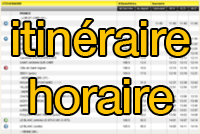
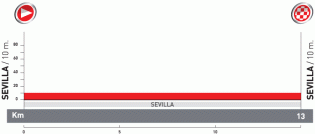

02/ Sunday 29 August 2010 : Alcalá de Guadaíra > Marbella - 173.7 km - plain
After the start from Alcalá de Guadaíra - which the Vuelta visits for the very first time in its 75 year old history - the riders will have to climb two third category mountains in this "plain" stage: the Alto de Pruna (620 m), whose top will be after 75 kilometers, and the Alto de Ronda (1.130 m) at 43 kilometers from the finish.After the first climb follows a 32 kilometer long descent and a final 11 kilometer long flat part: the perfect occasion for the sprinter teams to prepare a the first mass sprint of this Vuelta at the finish in Marbella (stage city for the 4th time, the last one was in 1996).
You'll find the time- and route schedule, the stage profile and the route on Google Maps for this stage below. Click on each of the images to open them.

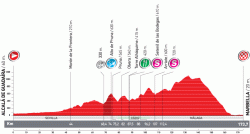

03/ Monday 30 August 2010 : Marbella > Málaga - 157.3 km - mountain stage
Immediately after the start from Marbella this first mountain stage starts with a third category climb, the Puerto de Ojén (550 m with a 4.8% average slope). About 80 kilometers further is the top of the Puerto del Léon (1st category, 905 m, 4.91% average slope) which will be climbed from Malaga where the peloton passes for the first time after 67 kilometers. After the descent of this mountain there will only be a few kilometers before a new climb of this mountain. After the second descent follows a small plain part, but the riders will finish the stage with a one and a half kilometer climb to the castle of Gibralfaro in Malaga!You'll find the time- and route schedule, the stage profile and the route on Google Maps for this stage below. Click on each of the images to open them.

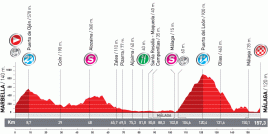
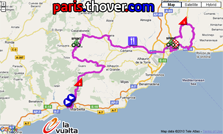
04/ Tuesday 31 August 2010 : Málaga > Valdepeñas de Jaén - 183.8 km - plain
After an easy and flat start of this stage the riders will climb three mountains before the finish in Valdepeñas de Jaen where the Vuelta never stopped before: the Alto Ventas de Zafarraya (2nd category, 910 m), the Alto de Montefrio (3rd category, 1.040 m) and finally the Puerto de Valdepeñas (2nd category, 1.100 m) at about 6 kilometers from the finish.You'll find the time- and route schedule, the stage profile and the route on Google Maps for this stage below. Click on each of the images to open them.

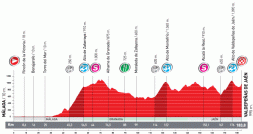
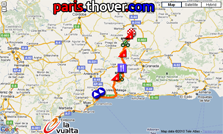
CONTINUE READING AFTER THIS ADVERTISEMENT
05/ Wednesday 1 September 2010 : Guadix > Lorca - 198.8 km - plain
This stage will either be the perfect occasion for a leading group which will go on until the finish or for a mass sprint.You'll find the time- and route schedule, the stage profile and the route on Google Maps for this stage below. Click on each of the images to open them.

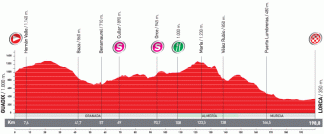
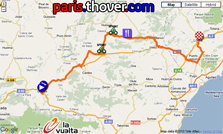
06/ Thursday 2 September 2010 : Caravace de la Cruz > Murcia - 151 km - plain
This is the second shortest stage and will start in Caravaca de Cruz. It will follow a completely flat route. At about 10 kilometers from the finish the riders will however find a short climb: the Alto de la Cresta del Gallo (2nd category, 370 m). Since it's positioned at only a few kilometers from the finish, it could well be an additional difficulty for the riders who were expecting a mass sprint finish in Murcia.You'll find the time- and route schedule, the stage profile and the route on Google Maps for this stage below. Click on each of the images to open them.

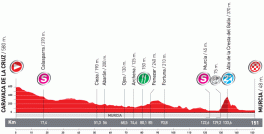
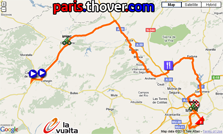
07/ Friday 3 September 2010 : Murcia > Orihuela - 187.1 km - plain
This stage will connect Murcia, a city which is used to receive the Vuelta, to Orihuela which will receive the Vuelta for the first time! The first 100 kilometers of this stage will follow a flat route and the top of the first difficulty of this stage, the Alto de Hondon de los Frailes (3rd category, 500 m), will be at 58 kilometers from the finish. The sprinters teams will thus most be probably be able to correctly position their rocket man for a stage victory in Orihuela.You'll find the time- and route schedule, the stage profile and the route on Google Maps for this stage below. Click on each of the images to open them.

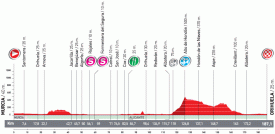
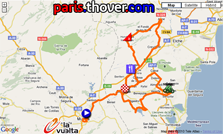
08/ Saturday 4 September 2010 : Villena > Xorret de Catí - 190 km - mountain stage
This Saturday the riders will have another mountain stage. Even though they'll have to wait until the end of the stage for a first category climb, this stage will be rather difficult and will immediately after the start from Villena (which the Vuelta visits for the first time) start the climb to the top of the Puerto de Onil (3rd category, 1O30 m). After a hilly part, 3 climbs of the 2nd category are waiting for the riders: the Puerto de Tudons (990 m), the Puerto de Torremanzanas (880 m) and the Puerto de Carrasqueta (1025 m). The last climb of this stage is the Alto del Catí (1st category, 1100 m) and it will probably give a spicy end to this stage, as it did the 4 previous times the Vuelta finished here.You'll find the time- and route schedule, the stage profile and the route on Google Maps for this stage below. Click on each of the images to open them.

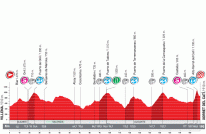
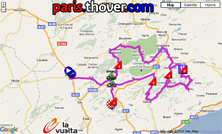
CONTINUE READING AFTER THIS ADVERTISEMENT
09/ Sunday 5 September 2010 : Calpe > Alcoy - 187.7 km - mountain stage
The second mountain stage of this superb weekend will lead the riders from Calpe, where several riders did their winter training (Johnny Hoogerland of the Vacansoleil Pro Cycling Team, the whole Katusha team, ...), to Alcoy over a 187 kilometer distance and with no less than 6 climb. After 50 flat kilometers starts the first climb to the top of the Coll de Rates (2nd category, 625 m). It will be followed by the combination of the Alto de Guadalest (2nd category, 680 m), the Alto de Confrides (3rd category, 980 m), the Alto de Tudons (2nd category, 1025 m), the Puerto de Torremanzanas (2nd category, 890 m) and finally the Puerto de Benifallim (3rd category, 1030 m) before the descent towards the finish in Alcoy.After this great mountain weekend the general ranking of this 65th Vuelta will probably start to show the first differences.
You'll find the time- and route schedule, the stage profile and the route on Google Maps for this stage below. Click on each of the images to open them.

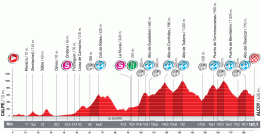
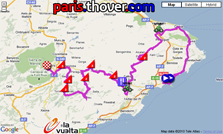
10/ Tuesday 7 September 2010 : Tarragona > Vilanova i la Geltrú - 175.7 km - plain
After the first well deserved rest day it's time for the 10th stage. After 120 kilometers the riders will pass the finish line for the first time. However, the stage will not stop there since they'll follow the coast line towards the climb of the Alto del Rat Penat (480 m), short but steep. The sprinters who chose this stage will either have to pass this climb with parts up to 20 to 22% or get back on the best climbers in the last 30 kilometers to pass the finish line first when they pass it for the second time!You'll find the time- and route schedule, the stage profile and the route on Google Maps for this stage below. Click on each of the images to open them.

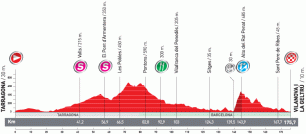
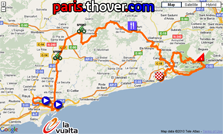
11/ Wednesday 8 September 2010 : Vilanova i la Geltrú > Andorra (Pal) - 208.4 km - mountain stage
Just like in the Tour de France 2009 the 75th anniversary of the Vuelta is celebrated in style with the stage to Andorra as the longest stage. The 208 kilometers of this stage are almost always climbing towards the mountain top finish (hors catégorie) in Pal in the Vallnord ski station. Yet another stage where the best climber, who will wear a new jersey in 2010 (because this jersey was red and the leader's jersey which was gold also becomes red in 2010, the best climber's jersey has changed as well ... and has adopted almost the same look with polka dots like in the Tour and in many other cycling races - the dots are blue though), can take some additional points to comfort his position!You'll find the time- and route schedule, the stage profile and the route on Google Maps for this stage below. Click on each of the images to open them.

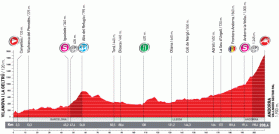
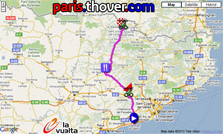
12/ Thursday 9 September 2010 : Andorra-la-Vella > Lleida - 172.5 km - plain
Again like in the Tour de France 2009 the next day's stage of the 65th Vuelta will also start in Andorra la Vella.Despite the climb of the Coll de Boixol which has its top at kilometer 57 (118 kilometers from the finish), the sprinters' teams will probably prepare a mass sprint at the end of this stage.
You'll find the time- and route schedule, the stage profile and the route on Google Maps for this stage below. Click on each of the images to open them.

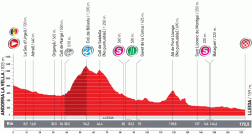
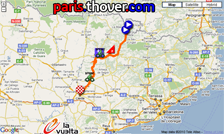
CONTINUE READING AFTER THIS ADVERTISEMENT
13/ Friday 10 September 2010 : Rincón de Soto > Burgos - 196 km - plain
Between Rincón de Soto and Burgos the riders will have two 3rd category climbs: the Alto de la Pradilla (1210 m) and the Alto de Valmala (1120 m). The top of the first climb will be at kilometer 135, while the second will be attained at about 30 kilometers from the finish. The perfect occasion for a leading group which could stay ahead until the finish.You'll find the time- and route schedule, the stage profile and the route on Google Maps for this stage below. Click on each of the images to open them.

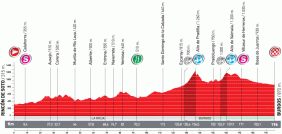
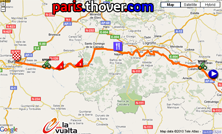
14/ Saturday 11 September 2010 : Burgos > Peña Cabarga - 178 km - mountain stage
After two plain stages, this weekend and on the following Monday the riders will again find 3 mountain stages. This Saturday it all starts with a stage with 4 difficulties, one of which being the climb to the mountain top finish in Peña Cabarga where the Vuelta came for the last time in 1979.After 78 kilometers the riders will be on the top of the Alto de Bocos (780 m, 3rd category) and after its descent they will immediately continue with the climb of the Portillo de Lunada (1350 m, 2nd category), followed by the Alto de Caracol (820 m, 2nd category). When the riders arrive at the top of this third climb they will start their descent to sea level before starting the last climb: a 1st category mountain with an average slope of 10%! The general ranking could well look a bit different after this stage!
You'll find the time- and route schedule, the stage profile and the route on Google Maps for this stage below. Click on each of the images to open them.

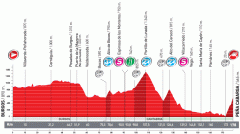
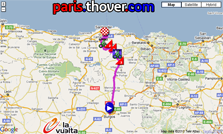
15/ Sunday 12 September 2010 : Solares > Lagos de Covadonga - 187.3 km - mountain stage
The second episode of this mountain weekend starts with about 150 flat kilometers following the coast line. The perfect occasion for one or more riders to create a leading group. However, at the end of the stage they will find a difficult climb towards the Covadonga Lakes.This hors catégorie climb is regularly part of the Tour of Spain since 1983 and is 12,6 kilometers long with a 7.3% average slope (height difference: 1056 m). To get to the top at a 1110 meters altitude, the riders -at 7 kilometers from the finish- the riders will have to get over the most difficult part at La Huesera: over 13% for a bit more than 500 meters. The last few years this part was often decisive for the stage win. The last time the Vuelta visited this mountain, in 2007, the stage victory was for Vladimir Efimkin. This climb is often seen as the Spanish Alpe d'Huez.
You'll find the time- and route schedule, the stage profile and the route on Google Maps for this stage below. Click on each of the images to open them.

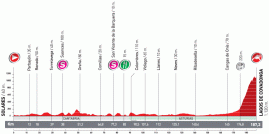
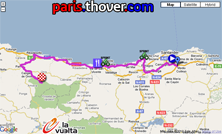
16/ Monday 13 September 2010 : Gijón > Cotobello - 181.4 km - mountain stage
This Monday the third mountain stage in row is awaiting the riders ... fortunately they can get some rest the next day.With no less than three 1st category climbs (one of which being the never used before climb to Cotobello) and one 3rd category climb this stage is one of the most difficult ones. After a bit more than 45 kilometers from the start in Gijón the riders already reach the top of the Alto de la Cabruñana (3rd category, 375 m). This will be followed by the 3 first category climbs: first the Alto de San Lorenzo (1350 m) with slopes up to 15%, followed by the Puerto de la Cobertoria (1174 m, average slope: 8.6%) and finally the 10 kilometer long climb to Cotobello with a 8.1% average slope with a maximum of 12% at several parts.
You'll find the time- and route schedule, the stage profile and the route on Google Maps for this stage below. Click on each of the images to open them.

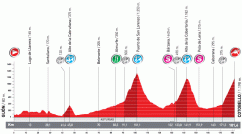
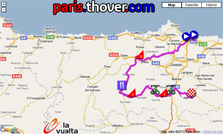
CONTINUE READING AFTER THIS ADVERTISEMENT
17/ Wednesday 15 September 2010 : Peñafiel > Peñafiel - 46 km - individual time trial
After the second rest day, it's time for the only individual time trial of this 65th Vuelta. With the finish and the start in a city which the Vuelta never visited before, Peñafiel, this stage proposes a completely flat route with long straight lines and thus perfect for time trial experts. That is, if they manage to get through the two first weeks without too much trouble!You'll find the time- and route schedule, the stage profile and the route on Google Maps for this stage below. Click on each of the images to open them.

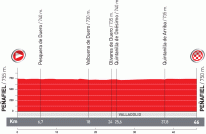
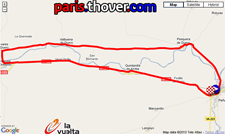
18/ Thursday 16 September 2010 : Valladolid > Salamanca - 148.9 km - plain
With its start from Valladolid this is a historical stage: not only because the Vuelta starts for the 34th time in this 65th edition but also because Valladolid was on 29 April 1935 (the Vuelta took place in April/May until 1995, it only found it's current positioning in August/September in 1996) the very first start city of the Vuelta.In this plain stage the sprinters will most probably try to pass the finish line first in Salamanca, if the wind is not going to spoil their plans and split up the peloton ...
You'll find the time- and route schedule, the stage profile and the route on Google Maps for this stage below. Click on each of the images to open them.

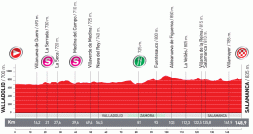
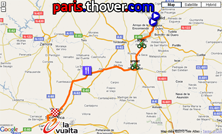
19/ Friday 17 September 2010 : Piedrahita > Toledo - 231.2 km - plain
With its 200 kilometers this is the second longest stage. After the start from Piedrahita, which will be visited for the very first time by the Vuelta, the riders will immediately start the climb of the Puerto de Chia (2nd category, 1670 m), but apart from this climb this stage's route is completely flat. The riders who still have some energy left will thus have a perfect occasion to get away in a leading group and try to get the stage win, except if the sprinters teams are able to get back on them before the finish.Ci-dessous vous trouverez l'itinéraire horaire, le profil et la carte Google Maps de cette étape. Cliquez sur chacune des images pour les agrandir.

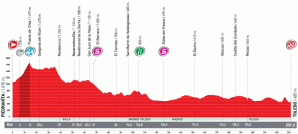

20/ Saturday 18 September 2010 : San Martín de Valdeiglesias > Bola del Mundo - 172.1 km - mountain stage
As usual, the Vuelta proposes a difficult mountain stage at the end which might lead to some final changes in the general ranking and thus keep some surprises until the very end.After the start from San Martín de Valdeiglesias the stage starts with a quite easy climb to the top of the Puerto de la Cruz Verde (3rd category, 1256 m). Than, the difficult part of the stage starts: first of all the climb to the Alto del Leon (1st category, 1515 m). After a short descent and a flat part they'll start the climb to the top of the Puerto de Navacerrada (1st category, 1870 m). After the descent towards Guadarrama the riders will climb the same mountain again. Once they arrive at the top, they will however continue for 3 kilometers to the top which was never visited before by the Vuelta, the Alto de las Guarramillas which is better known as the Bola del Mundo (hors catégorie, 2250 m). In this last part the riders will find slopes up to 12.5%.
You'll find the time- and route schedule, the stage profile and the route on Google Maps for this stage below. Click on each of the images to open them.

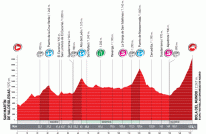
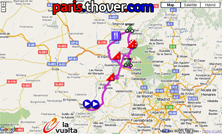
CONTINUE READING AFTER THIS ADVERTISEMENT
21/ Sunday 19 September 2010 : San Sebastián de los Reyes > Madrid - 85 km - plain
For this stage we know beforehand it will be done in slow motion while drinking a glass of champagne.For this edition the Vuelta organisor, Unipublic, decided to make it a very short stage of exactly 100 kilometers. After the start from San Sebastián de los Reyes the riders will thus rapidly find the usual circuit on the Paseo de la Castellana. This 6 kilometer circuit will be done about 8 times before -most probably- a sprinter will cross the finish line first on the Plaza de la Cibeles in Madrid!
You'll find the time- and route schedule, the stage profile and the route on Google Maps for this stage below. Click on each of the images to open them.

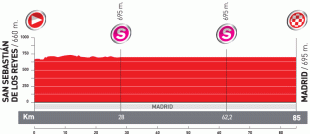
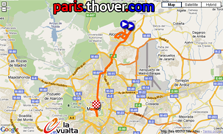
The 2010 Tour of Spain route, downloadable in Google Earth in KML format
You've just discovered all details of the stages of this Vuelta a España 2010 including the time and route schedules, the stage profiles and for each of the stages the route on Google Maps.If you would like to see the whole 2010 Tour of Spain at once, you can download the KML file below and open it with Google Earth.
>> Download the 2010 Vuelta a España route in Google Earth
This file will not only allow you to see the full route in Google Earth, but also to do a virtual fly-over over the route of one or more of the stages. To do so, you can of course use the default settings of Google Earth, but if you want to do a fly-over which really gives you the idea you were on your bike riding on the roads of the Vuelta a España 2010, I recommend you the following settings: in the menu Tools > Options choose the tab Touring and fill in the following choices on that tab:
- Camera tilt angle : 80.0 degrees
- Camera range : 150.0 meters
- Speed : 500.0 (if this makes you feel dizzy or if your computer or Internet connection don't allow you to get clear images with these settings, you can try lowering the speed) door Thomas Vergouwen
Vond u dit artikel interessant? Laat het uw vrienden op Facebook weten door op de buttons hieronder te klikken!
11 comments | 15501 views
this publication is published in: Vuelta a España | Vuelta a España 2010 | OpenStreetMap/Google Maps/Google Earth





 by marco1988 over
by marco1988 over
C'est incroyable ça, on en entend à peine parler en France. Je ne savais même pas que le tour d'Espagne commençais ce week-end. Vivement qu'il y ait un peu des coureurs français qui nous façent des performances pour qu'on parle d'autres courses que le Tour de France. J'espère que le jeune français champion du monde junior va percer à l'avenir parmi les meilleurs.
Bravo David Moncoutié !
je regarde en ce moment l etape de boladel mundo , petite route de beton champetre , la vuelta et le giro ose pas le tour . la caravane publicitaire on pourrait pas s en passer de tps a autre sur une montée atypique ?
sur les images tv les cars regie et des coureurs sont restés au col de navacerrada , quand on veut on peut
en même temps, quand tu vois les écarts en haut de la bola del mundo, tu te dis que c'est pas tellement plus sélectif que l'alpe d'huez....
Et le pied du col était vraiment ininteressant...
Autant les grands cols italiens (stelvio, Gavia, Mortirolo, Marmolada etc, ca fait rever, autant ces arrivées nulle part pas sélective sauf dans les 5 derniers kms, ca fait plus parler qu'autre chose
CQFD, Freddy,
René HAMM
oui c est vrai que le suspense fut maintenu sur cette vuelta caril y a pas beaucoup de gros cols pour fairtes des ecarts , tout etait pensé pour maintenir le suspense . aujourd hui c etait une autoroute jusqu a 3 km du sommet pour deboucher sur une route de beton ..ca passe d un extreme a l autre ,ca fait col superficiel . mais c etait pour l idée qu il y a moyen de degoter des itineraires secondaires , un granon ou un grand colombier est en bien meilleur etat que cette route en beton !
et vincent,, loin de moi l idée de comparer la difficulté des grands cols a ces montées seches :)
Bonsoir Freddy et Vincent,
Oui, les dix-huit premiers kilomètres vers le Bola del Mundo, qui empruntaient en grande partie la route du Puerto de Navacerrada, se sont courus sur une autoroute ou des grands boulevards, avec de longues lignes droites, sans virages en épingles à cheveux. Arcalis, quoi! Si la déclivité moyenne est de 6,2% sur 21,8 km, les trente-huit hectomètres terminaux affichent 11%, avec deux rampes de 19% et une de 20%. C'est sur cette portion, large d'environ deux mètres cinquante, qu'Ezequiel Mosquera se devait d'attaquer, mais Vincenzo Nibali, galvanisé par son maillot rouge de leader, a réussi à terminer dans le même temps que le Galicien.
En France, sauf errements ou amnésie de ma part, il n'existe pas de grimpées présentant un tel contraste. Même pas les 5,7 dernières bornes (à 9,1%) vers le Pic du Midi de Bigorre, qui nécessiteraient du reste un toilettage, si Christian Prudhomme et ses collègues imaginaient une arrivée aux Laquets. Ce ne sera jamais le cas!...
Par contre, il existe sous nos latitudes quelques ascensions, notamment au Pays Basque, très hard et d'une longueur supérieure. Par conséquent, nous assisterions, le cas échéant, à une bagarre plus palpitante qe cet après-midi. Je rassure Thomas Vergouwen et son pote ctrdyfl; je ne les relisterai pas ici.
Tchao,
René HAMM
@freddy, vincent & René : vous parlez de la Vuelta a España 2010 ... J'ai donc déplacé vos messages sur l'article au sujet de ce Grand Tour espagnol car ils ont beaucoup plus leur place ici :-).
Tout à fait d'accord avec toi Freddy! L'arrivée à la Bola del Mundo m'a fait penser au Zoncolan en Italie, pour moi l'un des plus dur d'Europe.
Sinon la montée du Grand Colombier depuis Talissieu présente 14km à 9% avec les 5 derniers à 12% et des passages à plus de 20 sur une route en bon état, de quoi faire une bonne sélection! (le Mont du Chat, pas loin, au-dessus du lac du Bourget, est également terrible).